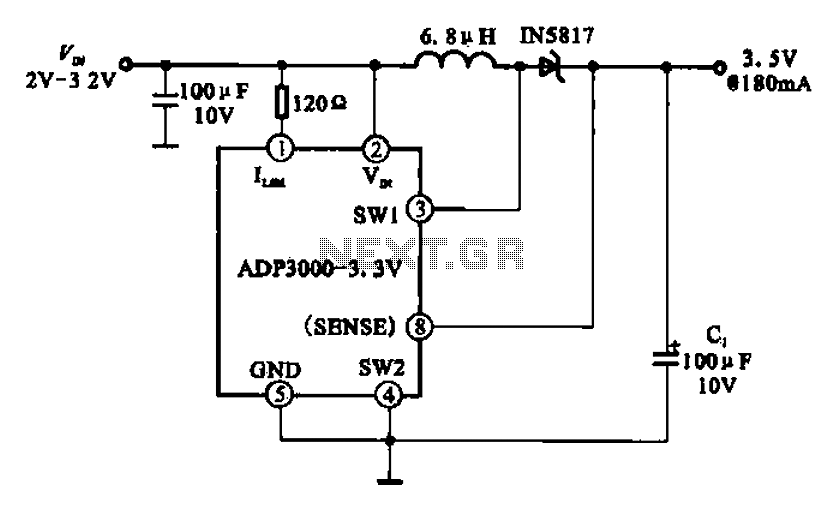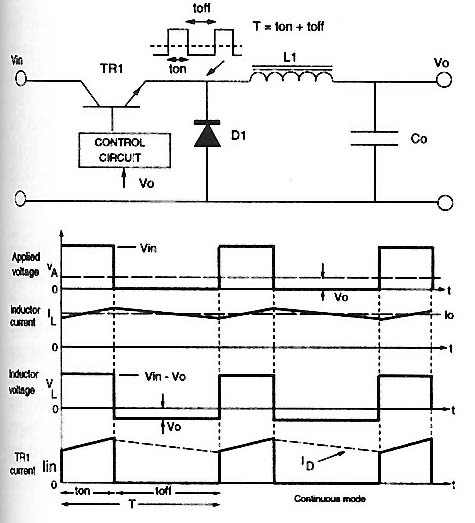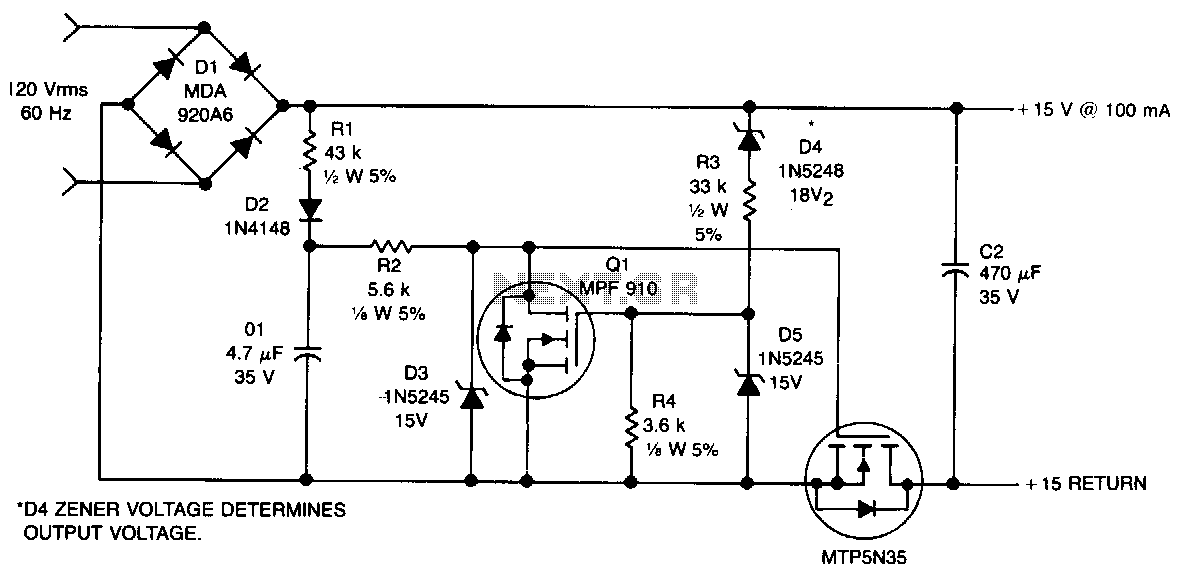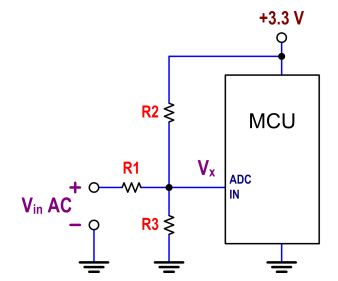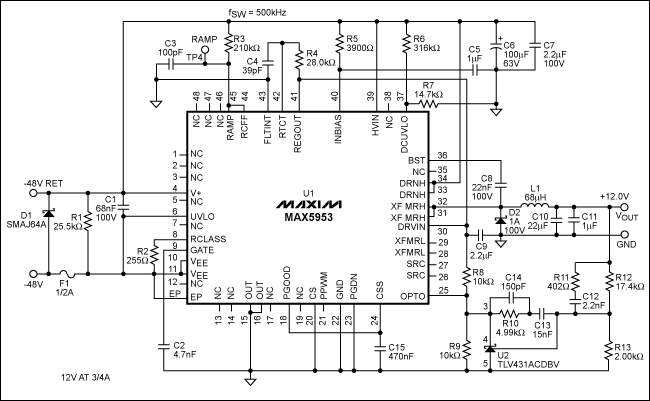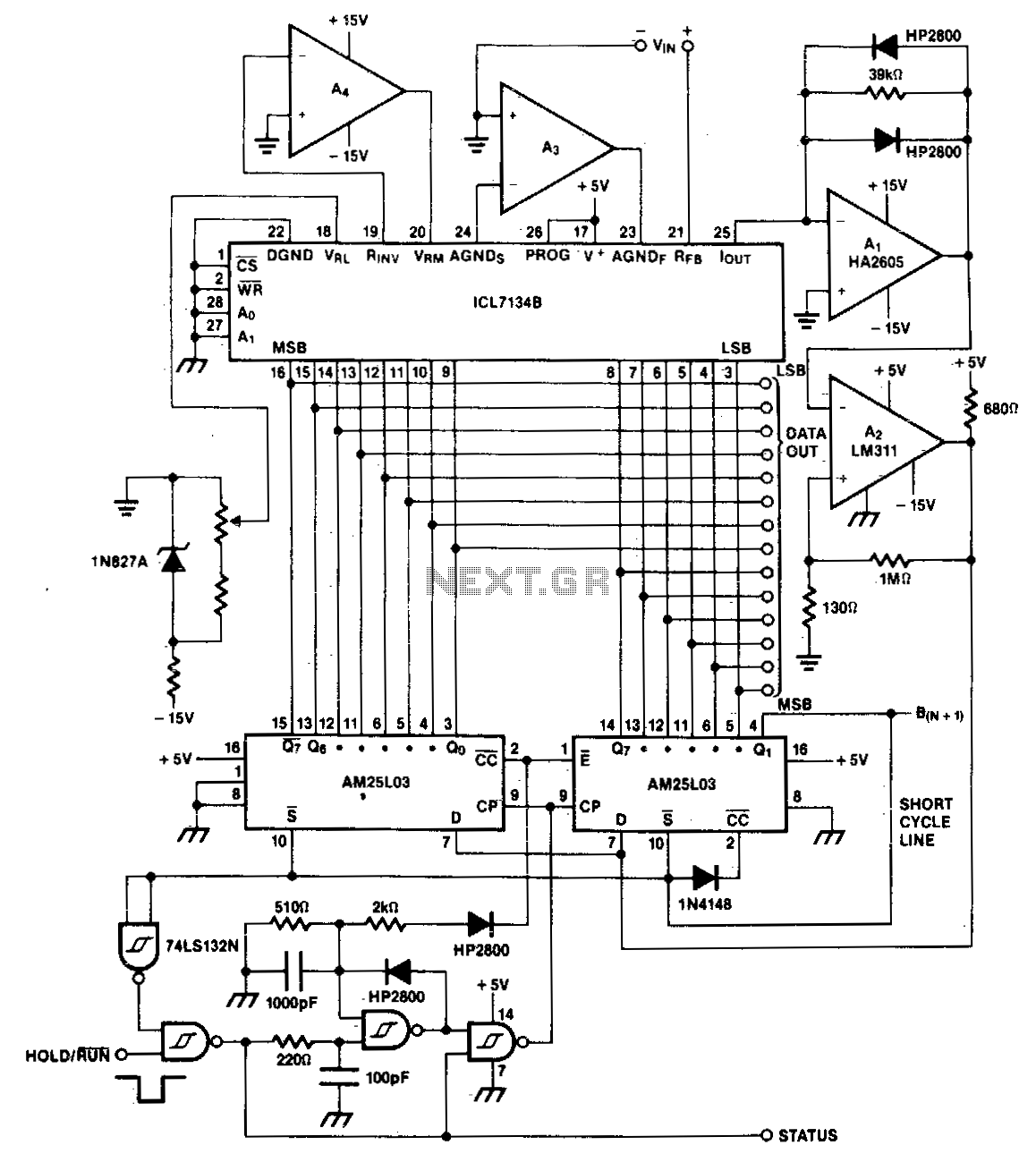
12kW PFC Boost Converter
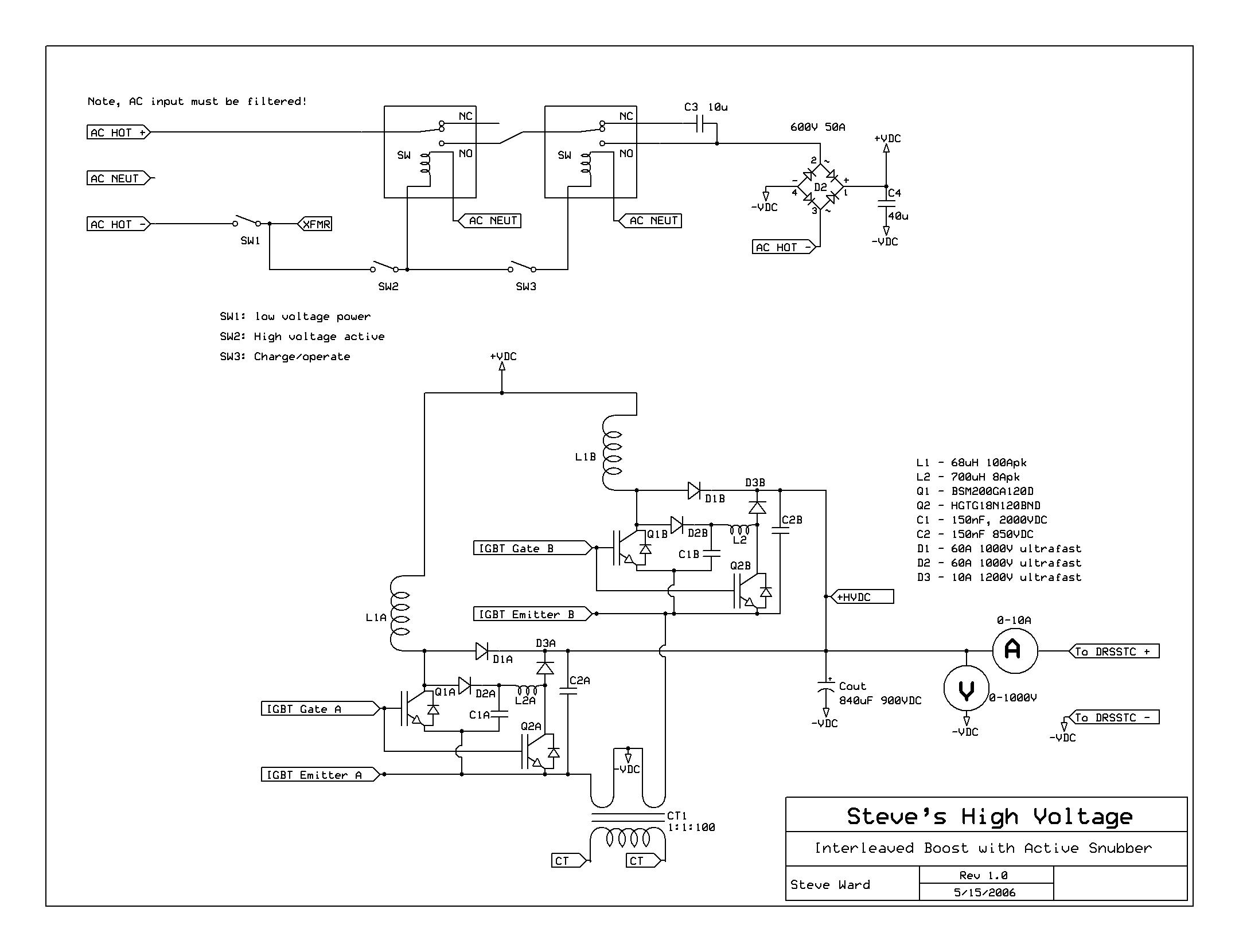
The project is a continuation of the 5kW Boost converter project. After several unsuccessful attempts, the focus shifted towards achieving a higher power level, targeting approximately 10kW. The title was modified from 12kW to 8kW, although the converter is designed for 12kW, it is unlikely that it will operate at that power level. The expected maximum output power is 800V at 10A DC, resulting in 8kW. The circuit operates as a discontinuous current, power factor correcting boost converter. Two converters are interleaved, each capable of a maximum input power of 6kW. An "active" snubber circuit is employed to recycle snubber energy, significantly reducing IGBT switching loss. Due to the discontinuous operation mode, two key conditions arise. First, the peak current is approximately twice that of a continuous mode converter. Second, since the IGBTs do not turn on with any current, the focus is primarily on turn-off losses, which can be substantial if not managed properly. Turn-off losses occur due to the instantaneous overlap of the IGBT voltage and current (in this case, 850VDC and 100A). Although this overlap is brief, it can lead to significant losses, resulting in overheating of the IGBTs. To mitigate this, a capacitor is placed across the IGBT to ensure that the instantaneous voltage at shut-off is 0V until the capacitor charges. A diode in series with the capacitor prevents discharge back through the IGBT when it turns on. The challenge then becomes managing the energy stored in this capacitor. Typically, a resistor is placed in parallel with the capacitor to drain off the charge, which effectively shifts the IGBT losses to heat dissipated in the resistor. However, in this design, the energy in the snubber capacitor is utilized to power a small boost converter. The energy stored in the capacitor is transferred to a small inductor through another IGBT. When the IGBT opens, the energy in the inductor is directed to the main output capacitor of the converter. PSPICE simulations indicated a significant reduction in power loss. Without the snubber circuit, IGBT losses were approximately 850W, while with the active snubber, losses decreased to around 200W while delivering 12kW. Although 200W is more manageable than 850W, it still necessitates substantial cooling, similar to what is required for typical computer CPUs dissipating 50-70W. To ensure the safety of the IGBTs and prevent saturation of the main inductors, a current monitoring system was established. Current transformers (CTs) were utilized to monitor the current, which contains a DC component. In a single converter setup, a diode in series with the CT output would allow the core to reset on every negative current pulse. However, with two converters, both are fed through the CT in opposing directions to maintain balanced voltage times seconds (v*s). A full-wave rectifier is used on the CT output, and should the CT voltage exceed a preset reference voltage, the controller immediately terminates the pulse, shutting off the IGBT. The controller ensures that the pulse width sent out from one converter matches the pulse length from the other. For instance, if current trips on pulse A, pulse B will also be truncated to the same length. The project has reached an exciting phase, with initial tests conducted using a bucket of slightly salty water as a dummy load. The converter was tested up to 4900W output (780V at 6.3A) for about 25 seconds, during which noticeable hydrogen production was observed through electrolysis.
The circuit design incorporates a dual interleaved boost converter topology, effectively distributing the load between two converters to enhance efficiency and reduce thermal stress on individual components. Each converter operates at a maximum of 6kW, with an active snubber circuit that recycles energy, thus minimizing losses associated with IGBT switching. The active snubber not only lowers the thermal burden on the IGBTs but also contributes to overall system efficiency by utilizing the energy stored in the snubber capacitor.
The IGBT switching strategy is critical, focusing on minimizing turn-off losses by ensuring that the voltage across the IGBT is clamped to zero during the turn-off transition. This is achieved through the strategic placement of a capacitor and a series diode, which prevents reverse current flow. The use of current transformers for monitoring allows for real-time feedback to the control system, ensuring that the system can react swiftly to overcurrent conditions, thereby protecting the IGBTs from potential damage.
The implementation of a full-wave rectifier at the output of the CT allows for accurate monitoring of the current flow, ensuring that the control logic can respond appropriately to any anomalies. The design emphasizes a balance between performance and reliability, with careful consideration given to thermal management and component ratings. This project represents a significant advancement in high-power boost converter technology, demonstrating the feasibility of operating at high efficiency while managing complex dynamic conditions.The project is a continuation of the 5kW Boost converter project. After a few failed attempts, I realized that I was really after more power, perhaps 10kW or so. I changed the title from 12kW to 8kW. While the converter is designed for 12kW, its very unlikely that I will ever run at that power level. So I expect the maximum output power to be 800V DC at 10ADC, so 8kW. Discontinuous current, power factor correcting boost converter. 2 converters are interleaved, each operating at 6kW maximum input power. There is an "active" snubber circuit that recycles snubber energy, this greatly reduces IGBT switching loss. Because the converter operates in a discontinuous mode, this implies 2 particular conditions. Firstly, the peak current will be about twice that of a continuous mode converter. Secondly, because the IGBTs don`t turn on with any current, we only care about the turn OFF losses, which will be quite high if not taken care of.
The Turn OFF loss is caused by the instantaneous overlap of the IGBT voltage and current (in this case 850VDC and 100A). This overlap is very short, but can cause quite a bit of loss, which equates to hot IGBTs. The trick is to then place a capacitor across the IGBT so that the instantaneous voltage at shut off, is 0V, that is, until the capacitor gets charged.
There is a diode in series with the capacitor, so that it could never discharge back through the IGBT when it turns ON. The problem then becomes: what to do with the energy in this capacitor A typical snubber places a resistor in parallel with this capacitor to drain off the charge.
In this case, we are basically shifting the IGBT losses to power dissipated in this resistor. The nice thing is that we can locate said resistor remotely, but still, we have to get rid of that heat. My approach is to, instead, make use of this energy stored in the snubber capacitor. Basically, this capacitor becomes the "power supply" for another small boost converter. The capacitors energy is dumped into a small inductor (through another IGBT). When the IGBT opens up, the energy in the inductor is forwarded to the main output capacitor of the converter.
My pspice simulations showed a dramatic drop in power loss. With no snubber circuit employed, IGBT losses totaled around 850W. With the active snubber, the total IGBT loss dropped to an amazing 200W, while delivering 12kW! Obviously, 200W is a lot easier to deal with than 850W, though will still require a considerable amount of cooling (consider a typical computer CPU dissipates 50-70W). In order to keep the IGBTs safe, and to avoid saturation of the main inductors, I needed a way to monitor the current through them.
Richie Burnett set me straight on how to use CTs to monitor this current (which has a DC component!). If I was using a single converter, the trick would be to use a diode in series with the CT output, so that the core would "reset" on every negative current pulse.
But, since I am using 2 converters, I can feed them both through the CT, but in *opposing* direction. This keeps the v*s balanced. I then need to use a full-wave rectifier on the output of the CT. If the CT voltage exceeds the preset reference voltage, the controller ends the pulse right there, shutting off the IGBT.
The controller (nicely) makes sure that the pulse width sent out from A is the same length that B will put out, and vice-versa. So if the current trips on pulse A, then pulse B will be that same truncated length. Finally I have reached the most exciting part of the project, actually seeing if the darn thing works!
A few weeks back I tested the converter with a bucket of slightly salty water as a dummy load. I ran it up to 4900W output (that`s 780V at 6. 3A). I only ran for about 25 seconds since I was producing what appeared to be a good amount of hydrogen through electrolysis. The most recent test was on 5/28/06 where I actually powered up my DRSSTC-2 with the power supp 🔗 External reference
The circuit design incorporates a dual interleaved boost converter topology, effectively distributing the load between two converters to enhance efficiency and reduce thermal stress on individual components. Each converter operates at a maximum of 6kW, with an active snubber circuit that recycles energy, thus minimizing losses associated with IGBT switching. The active snubber not only lowers the thermal burden on the IGBTs but also contributes to overall system efficiency by utilizing the energy stored in the snubber capacitor.
The IGBT switching strategy is critical, focusing on minimizing turn-off losses by ensuring that the voltage across the IGBT is clamped to zero during the turn-off transition. This is achieved through the strategic placement of a capacitor and a series diode, which prevents reverse current flow. The use of current transformers for monitoring allows for real-time feedback to the control system, ensuring that the system can react swiftly to overcurrent conditions, thereby protecting the IGBTs from potential damage.
The implementation of a full-wave rectifier at the output of the CT allows for accurate monitoring of the current flow, ensuring that the control logic can respond appropriately to any anomalies. The design emphasizes a balance between performance and reliability, with careful consideration given to thermal management and component ratings. This project represents a significant advancement in high-power boost converter technology, demonstrating the feasibility of operating at high efficiency while managing complex dynamic conditions.The project is a continuation of the 5kW Boost converter project. After a few failed attempts, I realized that I was really after more power, perhaps 10kW or so. I changed the title from 12kW to 8kW. While the converter is designed for 12kW, its very unlikely that I will ever run at that power level. So I expect the maximum output power to be 800V DC at 10ADC, so 8kW. Discontinuous current, power factor correcting boost converter. 2 converters are interleaved, each operating at 6kW maximum input power. There is an "active" snubber circuit that recycles snubber energy, this greatly reduces IGBT switching loss. Because the converter operates in a discontinuous mode, this implies 2 particular conditions. Firstly, the peak current will be about twice that of a continuous mode converter. Secondly, because the IGBTs don`t turn on with any current, we only care about the turn OFF losses, which will be quite high if not taken care of.
The Turn OFF loss is caused by the instantaneous overlap of the IGBT voltage and current (in this case 850VDC and 100A). This overlap is very short, but can cause quite a bit of loss, which equates to hot IGBTs. The trick is to then place a capacitor across the IGBT so that the instantaneous voltage at shut off, is 0V, that is, until the capacitor gets charged.
There is a diode in series with the capacitor, so that it could never discharge back through the IGBT when it turns ON. The problem then becomes: what to do with the energy in this capacitor A typical snubber places a resistor in parallel with this capacitor to drain off the charge.
In this case, we are basically shifting the IGBT losses to power dissipated in this resistor. The nice thing is that we can locate said resistor remotely, but still, we have to get rid of that heat. My approach is to, instead, make use of this energy stored in the snubber capacitor. Basically, this capacitor becomes the "power supply" for another small boost converter. The capacitors energy is dumped into a small inductor (through another IGBT). When the IGBT opens up, the energy in the inductor is forwarded to the main output capacitor of the converter.
My pspice simulations showed a dramatic drop in power loss. With no snubber circuit employed, IGBT losses totaled around 850W. With the active snubber, the total IGBT loss dropped to an amazing 200W, while delivering 12kW! Obviously, 200W is a lot easier to deal with than 850W, though will still require a considerable amount of cooling (consider a typical computer CPU dissipates 50-70W). In order to keep the IGBTs safe, and to avoid saturation of the main inductors, I needed a way to monitor the current through them.
Richie Burnett set me straight on how to use CTs to monitor this current (which has a DC component!). If I was using a single converter, the trick would be to use a diode in series with the CT output, so that the core would "reset" on every negative current pulse.
But, since I am using 2 converters, I can feed them both through the CT, but in *opposing* direction. This keeps the v*s balanced. I then need to use a full-wave rectifier on the output of the CT. If the CT voltage exceeds the preset reference voltage, the controller ends the pulse right there, shutting off the IGBT.
The controller (nicely) makes sure that the pulse width sent out from A is the same length that B will put out, and vice-versa. So if the current trips on pulse A, then pulse B will be that same truncated length. Finally I have reached the most exciting part of the project, actually seeing if the darn thing works!
A few weeks back I tested the converter with a bucket of slightly salty water as a dummy load. I ran it up to 4900W output (that`s 780V at 6. 3A). I only ran for about 25 seconds since I was producing what appeared to be a good amount of hydrogen through electrolysis. The most recent test was on 5/28/06 where I actually powered up my DRSSTC-2 with the power supp 🔗 External reference
